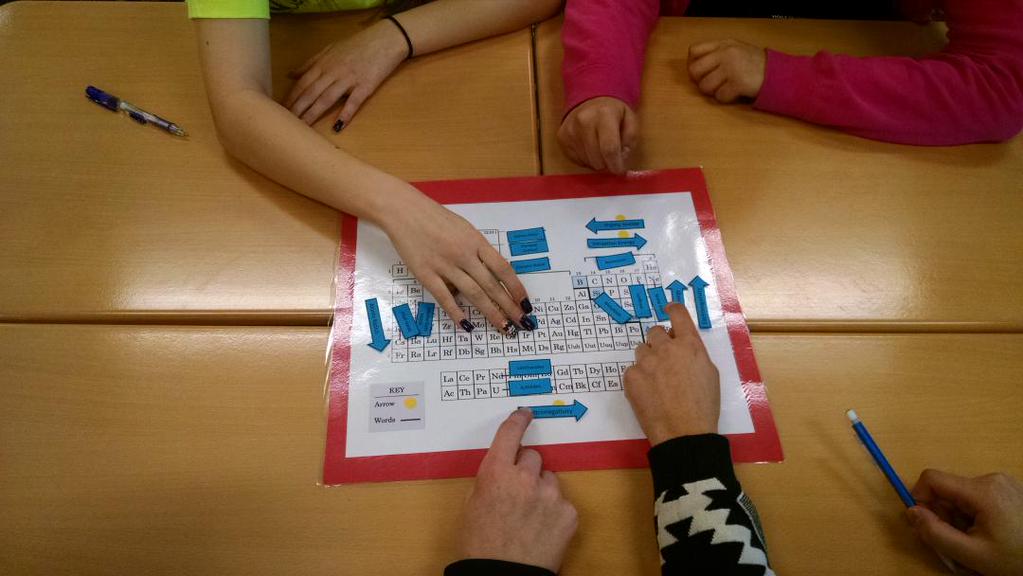
During our “Periodic Table and Periodicity" unit, we take about 3 days to learn the content and another 3-4 days to practice the content (more for Chemistry 1, less for Honors). One way that I have my students review the content is by playing a board game that I recreated from an NSTA conference a few years ago.
In this board game students are instructed to place words on their proper line/location (including names of families/groups and regions of the periodic table) and arrows on yellow dots pointing in the direction that that periodic trend increases (trends include: Electronegativity, Ionization Energy, and Atomic Size/Radius). Feel free to create additional periodic trend arrows depending on what you’ve covered in your own classroom.
In October 2012 I attended the Regional NSTA Conference in Louisville, KY. At this conference I attended a workshop about the inclusion of games in instruction that was presented by graduate students in the CISER program (Center for the Integration of STEM Education & Research) at Texas Tech University. Since then, I have included this game in each semester – and each semester I typically post a few photos of the game being played on Twitter. In doing so, I’ve received positive feedback from the students and my colleagues on Twitter. After being approached by an educator across the globe about this game recently, I decided to post about it on here to share it with a larger audience.
I will say that most of my students this semester really enjoyed playing the game. The enjoyment factor depended on the class period – one class period did really well and were “caught” strategizing between rounds to ensure that they knew each component of the periodic table well. Another class period seemed to play out of necessity only and did not seem to enjoy it as much nor did they recognize the benefit of the activity as a means for reviewing and practicing the new content.

Along with this blog post, I have provided links to the pdf with instructions and a jpeg of the game board that can be printed in color in most sizes. When I taught in Indianapolis, IN, I had boards that measured 24” x 30” glued onto poster boards for structural rigidity. Last year I remade the game and printed it in color at school on 11” x 17” paper. These boards were then glued onto construction paper and laminated. As far as the game pieces are concerned, you may have to play around with the pieces in the pdf. I ended up remaking mine on a PowerPoint slide when I couldn’t find my copy of the pdf. Otherwise, print out the pieces from the pdf. You may have to adjust the size of the print out and match it up to your game board to ensure a proper fit like I did.
I hope your students enjoy playing this game like my students have so far. Let me know if you have any questions!

NGSS
Students who demonstrate understanding can use the periodic table as a model to predict the relative properties of elements based on the patterns of electrons in the outermost energy level of atoms.
*More information about all DCI for HS-PS1 can be found at https://www.nextgenscience.org/dci-arrangement/hs-ps1-matter-and-its-interactions and further resources at https://www.nextgenscience.org.
Students who demonstrate understanding can use the periodic table as a model to predict the relative properties of elements based on the patterns of electrons in the outermost energy level of atoms.
Assessment is limited to main group elements. Assessment does not include quantitative understanding of ionization energy beyond relative trends.
Examples of properties that could be predicted from patterns could include reactivity of metals, types of bonds formed, numbers of bonds formed, and reactions with oxygen.

All comments must abide by the ChemEd X Comment Policy, are subject to review, and may be edited. Please allow one business day for your comment to be posted, if it is accepted.
Comments 4
Cards
What are the "cards" that are used?
Cards
Hi Lauren,
The cards are the vocabulary words that are included in the pdf with the directions. Some are a rectangle shape and others are an arrow shape that you can print off and cut out. You will find the pdfs above the image of the periodic table.
Points?
How exactly do you award points so that you know which students placed which card? Do you have them keep track of what they played and where?
Points
Hi Shana! I reached out to Dan. This is what he told me:
"I tried to simplify the point system as best I could. Rather than award individual students individual points, I split students into teams. They had to work as a team silently and one at a time in a circle to put their pieces down. When they were completed, they quietly raised their hand. The first team to have everything correct received the most points. If they missed it then they had to correct it and I went on to the next team that raised their hands. The number of points per game depended on the number of teams. If there were six teams, then the first place team in that round received six points. Second place, five. Third place, four. Etc. I kept track of the points tally on the whiteboard at the front of the classroom. I assigned each team a number or letter based on their place in the room to help keep track."